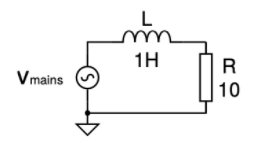Problem 2: Transformer circuit 1H R V mains 10 A transformer has a winding that has the equivalent circuit shown in the diagram. The winding is connected to the mains voltage, which has a frequency of 50 Hz and an rms voltage of 230 V. (a) What is the impedance of the transformer winding? Express your answer with magnitude and phase and correct units. (b) What current will flow through the winding? Express your answer as both a phasor and also as a function of time. Hint: You should assume the mains voltage has zero phase. (c) What are the power factor, the real power and the reactive power in the circuit?
Problem 2: Transformer circuit 1H R V mains 10 A transformer has a winding that has the equivalent circuit shown in the diagram. The winding is connected to the mains voltage, which has a frequency of 50 Hz and an rms voltage of 230 V. (a) What is the impedance of the transformer winding? Express your answer with magnitude and phase and correct units. (b) What current will flow through the winding? Express your answer as both a phasor and also as a function of time. Hint: You should assume the mains voltage has zero phase. (c) What are the power factor, the real power and the reactive power in the circuit?
Introductory Circuit Analysis (13th Edition)
13th Edition
ISBN:9780133923605
Author:Robert L. Boylestad
Publisher:Robert L. Boylestad
Chapter1: Introduction
Section: Chapter Questions
Problem 1P: Visit your local library (at school or home) and describe the extent to which it provides literature...
Related questions
Question
question below

Transcribed Image Text:Problem 2: Transformer circuit
L
m
1H
R
Vmains
10
A transformer has a winding that has the equivalent circuit shown in the diagram. The winding
is connected to the mains voltage, which has a frequency of 50 Hz and an rms voltage of 230 V.
(a) What is the impedance of the transformer winding? Express your answer with magnitude
and phase and correct units.
(b) What current will flow through the winding? Express your answer as both a phasor and
also as a function of time. Hint: You should assume the mains voltage has zero phase.
(c) What are the power factor, the real power and the reactive power in the circuit?
(d) Why do we use rms quanitities when performing power calculations for ac circuits?
(e) We could modify the winding circuit to be resonant by adding a capacitor in series with the
resistor and inductor. What capacitor value would we need to use if we wanted to have the
resonant frequency be at the mains frequency?
(f) Explain qualitatively what we would need to do if we wanted to make a sharper resonance.
Expert Solution
Step 1
NOTE: : Since we only answer up to 3 sub-parts, we’ll answer the first 3. Please resubmit the question and specify the other subparts (up to 3) you’d like answered.
Given Transformer circuit,

Mains voltage, Vmains= 230 V (rms)
At Frequency = 50 Hz
Step by step
Solved in 4 steps with 2 images

Knowledge Booster
Learn more about
Need a deep-dive on the concept behind this application? Look no further. Learn more about this topic, electrical-engineering and related others by exploring similar questions and additional content below.Recommended textbooks for you

Introductory Circuit Analysis (13th Edition)
Electrical Engineering
ISBN:
9780133923605
Author:
Robert L. Boylestad
Publisher:
PEARSON

Delmar's Standard Textbook Of Electricity
Electrical Engineering
ISBN:
9781337900348
Author:
Stephen L. Herman
Publisher:
Cengage Learning

Programmable Logic Controllers
Electrical Engineering
ISBN:
9780073373843
Author:
Frank D. Petruzella
Publisher:
McGraw-Hill Education

Introductory Circuit Analysis (13th Edition)
Electrical Engineering
ISBN:
9780133923605
Author:
Robert L. Boylestad
Publisher:
PEARSON

Delmar's Standard Textbook Of Electricity
Electrical Engineering
ISBN:
9781337900348
Author:
Stephen L. Herman
Publisher:
Cengage Learning

Programmable Logic Controllers
Electrical Engineering
ISBN:
9780073373843
Author:
Frank D. Petruzella
Publisher:
McGraw-Hill Education

Fundamentals of Electric Circuits
Electrical Engineering
ISBN:
9780078028229
Author:
Charles K Alexander, Matthew Sadiku
Publisher:
McGraw-Hill Education

Electric Circuits. (11th Edition)
Electrical Engineering
ISBN:
9780134746968
Author:
James W. Nilsson, Susan Riedel
Publisher:
PEARSON

Engineering Electromagnetics
Electrical Engineering
ISBN:
9780078028151
Author:
Hayt, William H. (william Hart), Jr, BUCK, John A.
Publisher:
Mcgraw-hill Education,